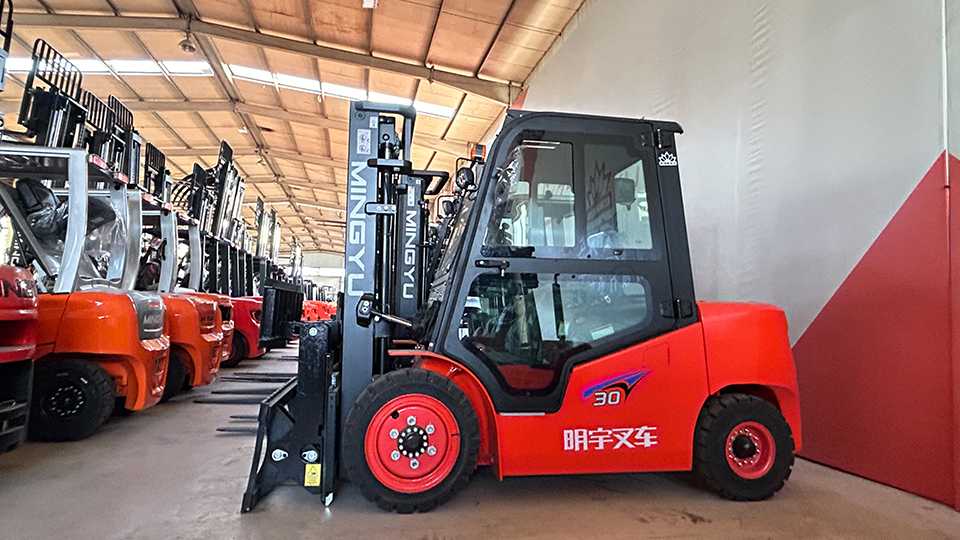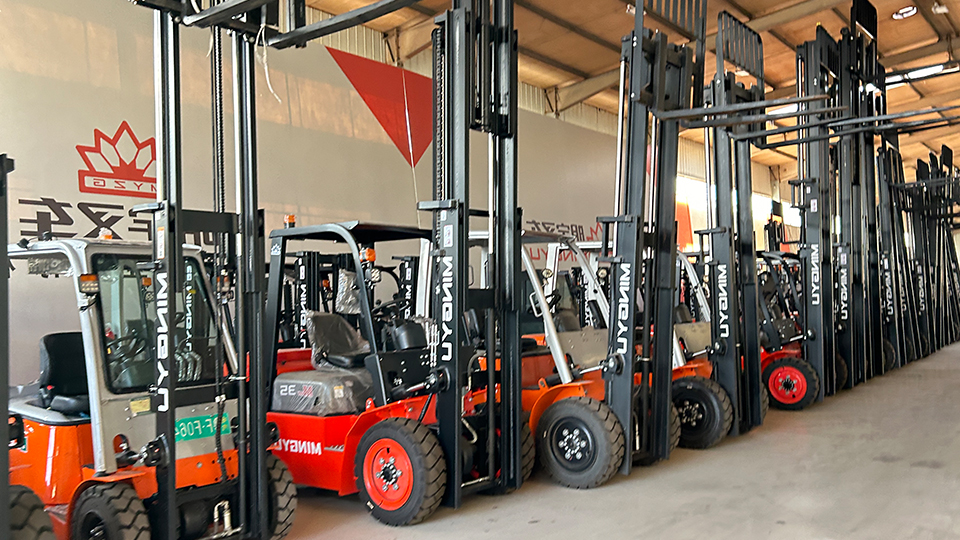
The Silent Workhorse: Understanding Battery-Operated Forklifts
In the ever-evolving landscape of material handling, the battery-operated forklift has emerged as a dominant force, offering a compelling alternative to its internal combustion (IC) engine counterparts. These electric-powered workhorses have transitioned from niche applications to become a staple in warehouses, distribution centers, manufacturing facilities, and various other industries. Their rise is driven by a confluence of factors, including environmental concerns, operational cost efficiencies, and advancements in battery technology. This technical article delves deep into the intricacies of battery-operated forklifts, exploring their components, working principles, advantages, disadvantages, different types, battery technologies, maintenance considerations, and their future trajectory in the material handling sector.
Core Components and Working Principles:
At its heart, a battery-operated forklift relies on a sophisticated interplay of electrical and mechanical systems. Understanding these core components and their working principles is fundamental to appreciating the capabilities and limitations of these machines:
Battery Pack: The heart of the system, the battery pack serves as the primary energy source. It typically consists of multiple interconnected lead-acid or lithium-ion cells, storing electrical energy that powers the forklift's various functions. The voltage and amp-hour capacity of the battery pack dictate the forklift's operating duration and power output.
Electric Motors: Unlike IC forklifts that utilize combustion engines, battery-operated forklifts employ one or more electric motors. These motors convert electrical energy from the battery into mechanical energy to drive the wheels (traction motor) and power the hydraulic system for lifting and tilting (hydraulic pump motor). Modern electric forklifts often utilize AC (alternating current) motors, which offer improved efficiency, reduced maintenance, and enhanced control compared to older DC (direct current) motor designs.
Controller: The controller acts as the "brain" of the forklift, regulating the flow of electrical power from the battery to the motors. It interprets operator input from the accelerator pedal, directional controls, and hydraulic levers, precisely controlling the speed, direction, and lifting functions of the forklift. Advanced controllers often incorporate features like regenerative braking, which captures kinetic energy during deceleration and converts it back into electrical energy to recharge the battery.

Hydraulic System: Similar to IC forklifts, battery-operated models utilize a hydraulic system to power the lifting and tilting mechanisms. An electric motor drives a hydraulic pump, which pressurizes hydraulic fluid. This pressurized fluid is then directed to hydraulic cylinders in the mast assembly to raise and lower the forks and tilt the mast.
Mast and Forks: The mast is the vertical structure that provides the lifting height, and the forks are the load-bearing attachments that engage with pallets or other materials. These components are typically made of high-strength steel and are designed to withstand significant loads.
Steering System: Battery-operated forklifts employ either hydraulic or electric power steering systems to provide the operator with precise control over the machine's direction. Electric power steering is becoming increasingly common due to its energy efficiency and responsiveness.
Braking System: Electric forklifts utilize a combination of braking mechanisms. Regenerative braking, as mentioned earlier, provides deceleration and energy recovery. Additionally, they are equipped with traditional mechanical brakes (drum or disc) for parking and emergency stopping.
Operator Controls and Dashboard: The operator interface includes controls for driving (accelerator, brake pedals, directional lever), lifting (hydraulic levers), tilting, and other auxiliary functions. The dashboard provides essential information such as battery charge level, speed, and fault indicators.
Advantages of Battery-Operated Forklifts:
The increasing popularity of battery-operated forklifts stems from a multitude of compelling advantages:
Zero Emissions: A significant environmental benefit is the complete absence of tailpipe emissions during operation. This makes them ideal for indoor applications, such as food processing plants, pharmaceutical facilities, and warehouses with sensitive air quality requirements, where IC engine exhaust fumes would be unacceptable.
Lower Operating Costs: While the initial purchase price of an electric forklift might be comparable to or slightly higher than an IC model, their long-term operating costs are typically lower. Electricity is generally cheaper than propane, diesel, or gasoline. Furthermore, electric forklifts have fewer moving parts, leading to reduced maintenance requirements and lower servicing costs.
Quieter Operation: Electric motors operate significantly quieter than combustion engines, contributing to a more comfortable and less noisy work environment. This can improve communication, reduce operator fatigue, and enhance overall workplace safety.
Smoother Operation and Better Maneuverability: Electric forklifts often offer smoother acceleration and deceleration, as well as more precise control. Their compact design and tighter turning radii can enhance maneuverability in confined spaces.
Reduced Heat Generation: Unlike IC engines that generate substantial heat, electric motors produce minimal heat, contributing to a cooler working environment, especially crucial in temperature-sensitive applications.
Lower Vibration: The lack of a reciprocating engine results in significantly lower vibration levels, leading to increased operator comfort and potentially reducing wear and tear on the forklift components.
Regenerative Braking: This feature not only assists in slowing down the forklift but also recovers energy, extending battery life and reducing energy consumption.
Disadvantages of Battery-Operated Forklifts:

Despite their numerous advantages, battery-operated forklifts also have certain limitations:
Higher Initial Purchase Price (Potentially): Depending on the model and battery technology, the initial investment in an electric forklift can be higher than an equivalent IC model. However, this can often be offset by lower long-term operating costs.
Limited Run Time: Battery life is finite and depends on the intensity of use and the battery's capacity. Continuous heavy-duty operation may require battery recharging or swapping during a shift, potentially leading to downtime.
Recharging Time and Infrastructure: Recharging a lead-acid battery can take several hours, requiring dedicated charging stations and potentially spare batteries for continuous operation. Lithium-ion batteries offer faster charging times but may have a higher upfront cost.
Battery Maintenance (Lead-Acid): Traditional lead-acid batteries require regular maintenance, including watering to maintain electrolyte levels, which can be time-consuming and requires proper safety procedures. Lithium-ion batteries generally require less maintenance.
Performance in Extreme Conditions: While advancements are being made, electric forklifts might have limitations in very demanding outdoor applications with uneven terrain or extreme temperatures compared to robust IC models.
Battery Replacement Cost: Forklift batteries, especially lithium-ion, can be a significant expense when they reach the end of their lifespan.
Types of Battery-Operated Forklifts:
Battery-operated forklifts are available in various configurations to suit different applications:
Counterbalance Forklifts: These are the most common type, featuring forks extending from the front and a counterweight at the rear for stability. Electric counterbalance forklifts are widely used in warehouses and manufacturing.
Reach Trucks: Designed for narrow aisle warehouses, reach trucks have outrigger legs and forks that can extend forward, allowing them to access high racking. Electric reach trucks are highly maneuverable and efficient in maximizing storage density.
Pallet Jacks and Stackers: These are lower-lift, pedestrian or rider-operated machines used for moving and stacking pallets at lower heights. Electric pallet jacks and stackers are ideal for loading/unloading trucks and short-distance transport in warehouses.
Order Pickers: Specifically designed for retrieving individual items from storage locations, order pickers lift the operator to the required height. Electric order pickers enhance efficiency and safety in order fulfillment operations.
Rough Terrain Electric Forklifts: While less common than IC rough terrain models, electric rough terrain forklifts with larger tires and robust construction are emerging for outdoor applications with moderately uneven surfaces.
Battery Technologies: Powering the Electric Revolution:
The performance and practicality of battery-operated forklifts are intrinsically linked to the underlying battery technology. The two primary types currently used are:
Lead-Acid Batteries: These are the traditional and more established technology for electric forklifts. They are relatively cost-effective upfront but require regular maintenance (watering) and have longer recharge times. Their energy density is lower compared to lithium-ion, resulting in shorter run times for a given size.
Lithium-Ion Batteries: This newer technology is gaining significant traction due to its numerous advantages. Lithium-ion batteries offer faster charging times, higher energy density (longer run times), require minimal maintenance, have a longer lifespan, and provide more consistent power delivery throughout the discharge cycle. While the initial cost is higher, the total cost of ownership can be lower in the long run due to reduced downtime and longer lifespan.
Maintenance Considerations for Battery-Operated Forklifts:
Maintaining a battery-operated forklift is crucial for ensuring its longevity, safety, and optimal performance:
Battery Care (Lead-Acid): Regular watering to maintain electrolyte levels is essential. Overcharging and deep discharging should be avoided to prolong battery life. Proper cleaning of battery terminals and connections is also important.
Battery Charging: Following the manufacturer's recommendations for charging procedures is crucial. Allowing lead-acid batteries to cool down before recharging and ensuring proper ventilation in charging areas are important safety considerations.
General Forklift Maintenance: Regular inspections of tires, brakes, lights, and hydraulic systems are necessary. Lubrication of moving parts and timely replacement of worn components are also important.
Electrical System Checks: Periodic inspection of wiring, connectors, and motor brushes (in DC motors) is essential to identify and address any potential electrical issues.
Controller Diagnostics: Modern electric forklifts often have diagnostic systems that can help identify faults in the controller and other electrical components.
The Future of Battery-Operated Forklifts:
The future of battery-operated forklifts looks promising, driven by ongoing advancements in battery technology, increasing environmental awareness, and the pursuit of operational efficiencies. Key trends shaping the future include:
Continued Advancements in Lithium-Ion Technology: Expect further improvements in energy density, charging speeds, and lifespan of lithium-ion batteries, making electric forklifts even more competitive with IC models in demanding applications.
Wireless Charging: Emerging wireless charging technologies could eliminate the need for manual plugging and unplugging, further streamlining operations and reducing downtime.
Fuel Cell Technology: While still in early stages for widespread forklift adoption, hydrogen fuel cells offer the potential for zero-emission operation with rapid refueling times, bridging the gap between battery electric and traditional IC power.
Increased Automation and Integration: Electric forklifts are well-suited for integration with automated guided vehicle (AGV) systems and warehouse management software, contributing to more efficient and intelligent material handling operations.
Government Regulations and Incentives: Increasingly stringent emission regulations and potential government incentives for electric vehicle adoption are likely to further accelerate the transition towards battery-operated forklifts.
Conclusion:
The battery-operated forklift has firmly established itself as a vital component of modern material handling. Its inherent advantages in terms of emissions, noise, operating costs, and maneuverability make it an increasingly attractive choice for a wide range of applications. As battery technology continues to evolve and costs decrease, the adoption of electric forklifts is expected to accelerate further, solidifying their position as the silent workhorses of warehouses and beyond, contributing to more sustainable and efficient material handling practices. Understanding their intricacies, from core components to future trends, is essential for businesses looking to optimize their operations and embrace the electric revolution in material handling.
Name: selena
Mobile:+86-13176910558
Tel:+86-0535-2090977
Whatsapp:8613181602336
Email:vip@mingyuforklift.com
Add:Xiaqiu Town, Laizhou, Yantai City, Shandong Province, China